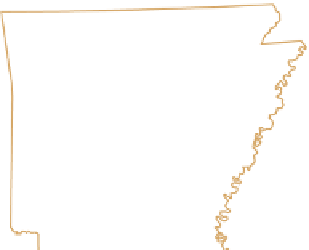Geoscience Reference
In-Depth Information
the
pressure gradient force
. It is useful to think of a “gradient” as
being analogous to the slope between two places on the surface of
Earth. If the elevation of one place is significantly higher than the
other, then the slope is said to be steeper than if the locations were
located at or near each other. The pressure gradient force operates
on the same principle: the greater the difference in surface pres-
sures between two regions, the steeper the pressure gradient. The
process of airflow is significantly affected by the pressure gradient
because the greater the pressure difference between two places, the
faster the air flows from high to low to equalize the pressure.
Figure 6.10 is a barometric map that illustrates the pressure
gradient force. The map focuses on a hypothetical difference
in surface air pressure between Oklahoma City, Oklahoma,
and Nashville, Tennessee. In this image, the center of the high
pressure (indicated by the “H”) is located in Oklahoma City,
whereas the center of the low (indicated by the “L”) is located
in Nashville. Air pressure in this figure ranges from 1028 mb
at the center of the high to 992 mb at the center of the low. It
should make sense to you that as a result of this variation, the
air is generally flowing from west to east (left to right on the
map)—that is, from the Oklahoma City area toward Nashville.
Close to the center of the high—say, from Oklahoma City
to central Arkansas—the isobars are widely spaced. This means
that very limited pressure change occurs across this portion of
the Earth's surface at this particular point in time. Thus, the pres-
sure gradient in this part of the circulatory system is shallow. If
you were in this area on this particular day, you would find the
The Convection Process
4
Rising air cools
5
Cool air
sinks
5
Cool air
sinks
Sun's energy
heats the
ground surface
1
Warm air rises
3
Advection
Convection
C
The warmed ground heats the air
above it
2
Figure 6.9 Atmospheric convection.
Convection occurs
when one portion of the Earth's surface is heated relative to
another. When this happens, a large “bubble” of air lifts from
the surface.
are the overall method through which heat is distributed around
the planet. Once the air is set in motion in this manner, the other
forces—pressure gradient, Coriolis, frictional—then directly
influence the movement of the air.
Pressure Gradient Force
As we discussed earlier, air generally flows from areas of high pres-
sure to regions of low pressure. The variable that drives the move-
ment of air between two areas at different pressures is referred to as
Pressure gradient force
The difference in barometric pres-
sure that exists between adjacent zones of low and high pres-
sure that results in airflow.
ILLINOIS
MISSOURI
KANSAS
KENTUCKY
1020 mb
990 mb
m
OKLAHOMA
L
Nashville
Nashville
Oklahoma City
Oklahoma City
TENNESSEE
TENNESSEE
H
Memphis
ARKANSAS
ARKANSAS
M I S S I S S I P P I
TEXAS
Figure 6.10 Hypothetical pressure gradient between Oklahoma City, Oklahoma, and Nashville, Tennes-
see.
Notice the direction of airflow and the spacing of isobars across the region. A steep pressure gradient exists in
regions where isobars are closely spaced together, whereas the gradient is shallow in places where the isobars are far apart.
























































































